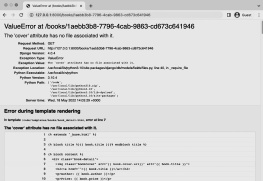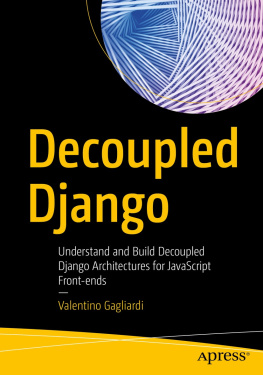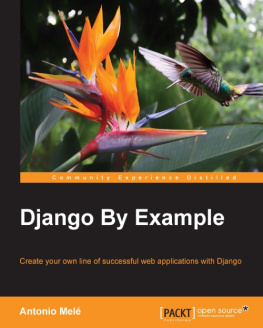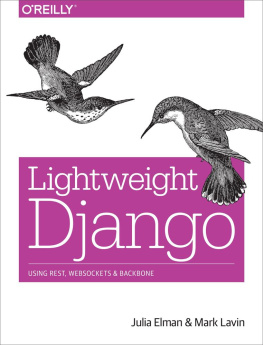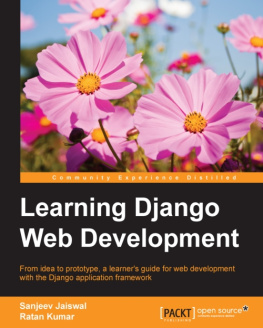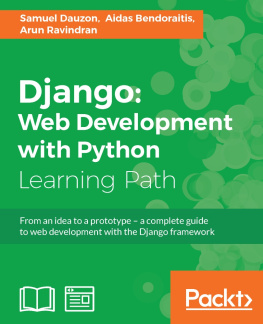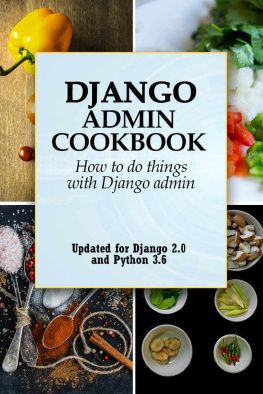William S. Vincent - Django for APIs
Here you can read online William S. Vincent - Django for APIs full text of the book (entire story) in english for free. Download pdf and epub, get meaning, cover and reviews about this ebook. year: 2018, publisher: leanpub.com, genre: Computer. Description of the work, (preface) as well as reviews are available. Best literature library LitArk.com created for fans of good reading and offers a wide selection of genres:
Romance novel
Science fiction
Adventure
Detective
Science
History
Home and family
Prose
Art
Politics
Computer
Non-fiction
Religion
Business
Children
Humor
Choose a favorite category and find really read worthwhile books. Enjoy immersion in the world of imagination, feel the emotions of the characters or learn something new for yourself, make an fascinating discovery.

- Book:Django for APIs
- Author:
- Publisher:leanpub.com
- Genre:
- Year:2018
- Rating:5 / 5
- Favourites:Add to favourites
- Your mark:
- 100
- 1
- 2
- 3
- 4
- 5
Django for APIs: summary, description and annotation
We offer to read an annotation, description, summary or preface (depends on what the author of the book "Django for APIs" wrote himself). If you haven't found the necessary information about the book — write in the comments, we will try to find it.
Django for APIs — read online for free the complete book (whole text) full work
Below is the text of the book, divided by pages. System saving the place of the last page read, allows you to conveniently read the book "Django for APIs" online for free, without having to search again every time where you left off. Put a bookmark, and you can go to the page where you finished reading at any time.
Font size:
Interval:
Bookmark:

This book is for sale at http://leanpub.com/djangoforapis
This version was published on 2020-08-13
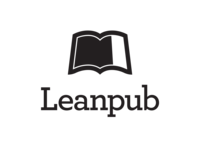
* * * * *
This is a Leanpub book. Leanpub empowers authors and publishers with the Lean Publishing process. Lean Publishing is the act of publishing an in-progress ebook using lightweight tools and many iterations to get reader feedback, pivot until you have the right book and build traction once you do.
* * * * *
The internet is powered by RESTful APIs. Behind the scenes even the simplest online task involves multiple computers interacting with one another.
An API (Application Programming Interface) is a formal way to describe two computers communicating directly with one another. And while there are multiple ways to build an API, web APIswhich allow for the transfer of data over the world wide webare overwhelmingly structured in a RESTful (REpresentational State Transfer) pattern.
In this book you will learn how to build multiple RESTful web APIs of increasing complexity from scratch using Django and Django REST Framework, one of the most popular and customizable ways to build web APIs, used by many of the largest tech companies in the world including Instagram, Mozilla, Pinterest, and Bitbucket. This approach is also uniquely well-suited to beginners because Djangos batteries-included approach masks much of the underlying complexity and security risks involved in creating any web API.
If youre brand new to web development with Django, I recommend first reading my previous book Django for Beginners. The first several chapters are available for free online and cover proper set up, a Hello World app, and a Pages app. The full-length version goes deeper and covers a Blog website with forms and user accounts as well as a production-ready Newspaper site that features a custom user model, complete user authentication flow, emails, permissions, deployment, environment variables, and more.
This background in traditional Django is important since Django REST Framework deliberately mimics many Django conventions.
It is also recommended that readers have a basic knowledge of Python itself. Truly mastering Python takes years, but with just a little bit of knowledge you can dive right in and start building things.
Django was first released in 2005 and at the time most websites consisted of one large monolithic codebase. The back-end consisted of database models, URLs, and views which interacted with the front-end templates of HTML, CSS, and JavaScript that controlled the presentational layout of each web page.
However in recent years an API-first approach has emerged as arguably the dominant paradigm in web development. This approach involves formally separating the back-end from the front-end. It means Django becomes a powerful database and API instead of just a website framework.
Today Django is arguably used more often as just a back-end API rather than a full monolithic website solution at large companies!
An obvious question at this point is, Why bother? Traditional Django works quite well on its own and transforming a Django site into a web API seems like a lot of extra work. Plus, as a developer, you then have to write a dedicated front-end in another programming language.
This approach of dividing services into different components, by the way, is broadly known as Service-oriented architecture.
It turns out however that there are multiple advantages to separating the front-end from the back-end. First, it is arguably much more future-proof because a back-end API can be consumed by any JavaScript front-end. Given the rapid rate of change in front-end librariesReact was only released in 2013 and Vue in 2014!this is highly valuable. When the current front-end frameworks are eventually replaced by even newer ones in the years to come, the back-end API can remain the same. No major rewrite is required.
Second, an API can support multiple front-ends written in different languages and frameworks. Consider that JavaScript is used for web front-ends, while Android apps require the Java programming language, and iOS apps need the Swift programming language. With a traditional monolithic approach, a Django website cannot support these various front-ends. But with an internal API, all three can communicate with the same underlying database back-end!
Third, an API-first approach can be used both internally and externally. When I worked at Quizlet back in 2010, we did not have the resources to develop our own iOS or Android apps. But we did have an external API available that more than 30 developers used to create their own flashcard apps powered by the Quizlet database. Several of these apps were downloaded over a million times, enriching the developers and increasing the reach of Quizlet at the same time. Quizlet is now a top 20 website in the U.S. during the school year.
The major downside to an API-first approach is that it requires more configuration than a traditional Django application. However as we will see in this book, the fantastic Django REST Framework library removes much of this complexity.
There are hundreds and hundreds of third-party apps available that add further functionality to Django. You can see a complete, searchable list over at Django Packages, as well as a curated list in the awesome-django repo. However, among all third-party applications, Django REST Framework is arguably the killer app for Django. It is mature, full of features, customizable, testable, and extremely well-documented. It also purposefully mimics many of Djangos traditional conventions, which makes learning it much faster. And it is written in the Python programming language, a wonderful, popular, and accessible language.
If you already know Django, then learning Django REST Framework is a logical next step. With a minimal amount of code, it can transform any existing Django application into a web API.
I wrote this book because there is a distinct lack of good resources available for developers new to Django REST Framework. The assumption seems to be that everyone already knows all about APIs, HTTP, REST, and the like. My own journey in learning how to build web APIs was frustrating and I already knew Django well enough to write a book on it!
This book is the guide I wish existed when starting out with Django REST Framework.
Chapter 1 begins with a brief introduction to web APIs and the HTTP protocol. In Chapter 2 we review the differences between traditional Django and Django REST Framework by building out a Library book website and then adding an API to it. Then in Chapters 3-4 we build a Todo API and connect it to a React front-end. The same process can be used to connect any dedicated front-end (web, iOS, Android, desktop, or other) to a web API back-end.
In Chapters 5-9 we build out a production-ready Blog API which includes full CRUD functionality. We also cover in-depth permissions, user authentication, viewsets, routers, documentation, and more.
Font size:
Interval:
Bookmark:
Similar books «Django for APIs»
Look at similar books to Django for APIs. We have selected literature similar in name and meaning in the hope of providing readers with more options to find new, interesting, not yet read works.
Discussion, reviews of the book Django for APIs and just readers' own opinions. Leave your comments, write what you think about the work, its meaning or the main characters. Specify what exactly you liked and what you didn't like, and why you think so.

